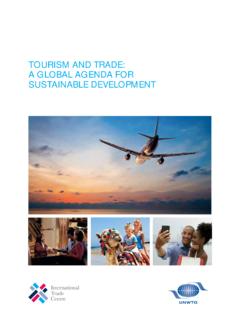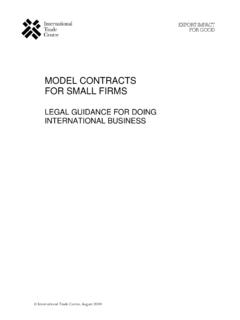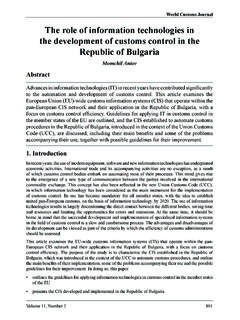Transcription of CHARTING A ROADMAP TO REGIONAL …
1 CHARTING A ROADMAP TO REGIONAL . integration with THE WTO. trade facilitation agreement . trade IMPACT. FOR GOOD. CHARTING a ROADMAP to REGIONAL integration with the WTO. trade facilitation agreement CHARTING a ROADMAP to REGIONAL integration with the WTO trade facilitation agreement About the paper Small and medium-sized enterprises (SMEs) can benefit more if the WTO trade facilitation agreement is implemented in a coordinated manner at REGIONAL level. This report charts a ROADMAP for REGIONAL policy frameworks on trade facilitation . Such arrangements have the potential to boost intraregional trade , reduce bottlenecks and increase the participation of SMEs in REGIONAL value chains, thus deepening REGIONAL integration .
2 Publisher: International trade Centre Title: CHARTING a ROADMAP to REGIONAL integration with the WTO trade facilitation agreement Publication date and place: Geneva, December 2017. Page count: 56. Language: English ITC Document Number: Citation: International trade Centre (2017). CHARTING a ROADMAP to REGIONAL integration with the WTO trade facilitation agreement . ITC, Geneva. For more information, contact: Mohammad Saeed, ITC encourages the reprinting and translation of its publications to achieve wider dissemination. Short extracts of this paper may be freely reproduced, with due acknowledgement of the source. Permission should be requested for more extensive reproduction or translation.
3 A copy of the reprinted or translated material should be sent to ITC. Digital image on the cover: Shutterstock International trade Centre (ITC). ITC is the joint agency of the World trade Organization and the United Nations. ii CHARTING a ROADMAP to REGIONAL integration with the WTO trade facilitation agreement Foreword Effective REGIONAL integration is an important stepping stone for countries to have greater insertion into global trade . trade facilitation both in terms of the World trade Organization (WTO) trade facilitation agreement (TFA) and the wider interpretation including non-tariff barriers, rules of origin, standards and the business environment is a fundamental element of making integration work for economies and for people.
4 Removing obstacles to cross-border trade is one of the key objectives of REGIONAL economic communities (RECs) as they work towards this deeper integration . But this is not an automatic process. It takes careful planning, sequencing and investment in both hard and soft infrastructure at the country and REGIONAL level for trade facilitation initiatives to be sustainable and have real impact. However, the figures on intraregional trade continue to show a disconnection between the well accepted policy objective of deeper integration and what is actually happening on the ground. Africa still has incredible unrealized potential in increasing its level of intraregional trade , which, at just 18%, compares unfavorably to that in Europe and Asia with 69% and 52% respectively.
5 But policies are going in the right direction. One only has to look at the progress made in some REGIONAL integration movements such as the East African Community (EAC) and the commitment to the Continental Free trade agreement to know that this remains high on the policy radar. A multilateral milestone was reached in 2017 with the entry into force of WTO's trade facilitation agreement . The TFA creates binding obligations for WTO Members to improve the transparency, predictability, fairness and efficiency of their cross-border procedures by simplifying, standardizing and automating trade practices and expanding thecoordination of border regulatory agencies. Although trade facilitation reforms are already under way in many countries, the agreement gave new impetus to tackle bureaucratic delays and red tape' giving RECs a unique opportunity to promote concerted cross-border reforms.
6 REGIONAL approaches to implement trade facilitation measures can deliver greater benefits to individual countries and the REGIONAL community than just unconnected national reforms. Coordinated cross-border reforms would help create a more consistent and predictable REGIONAL trading environment by avoiding the imposition of diverging administrative procedures and requirements in each member state. Harmonized formalities across regions would reduce business transaction costs, create the necessary condition for the development of REGIONAL value chains and be an important investment tool. To help RECs foster a conducive business environment, the International trade Centre (ITC) has developed a toolkit' to assist policymakers in designing, implementing and monitoring REGIONAL trade facilitation reforms.
7 This toolkit provides a comprehensive review of relevant instruments and approaches available to REGIONAL institutions and their member states. Its aim is to support RECs in designing REGIONAL trade facilitation reforms tailored to their needs and resources that will deepen the REGIONAL integration process by promoting simpler, cheaper and faster intraregional trade transactions for businesses. We encourage policymakers in RECs to make use of this ROADMAP to implement REGIONAL trade facilitation policies to help business communities thrive and reinvigorate paths of REGIONAL integration . Arancha Gonz lez Executive Director International trade Centre iii CHARTING a ROADMAP to REGIONAL integration with the WTO trade facilitation agreement Acknowledgements The International trade Centre (ITC) expresses its gratitude to all parties involved in the development of this publication, prepared by the external consultant for trade facilitation , Birgit Viohl, as well as Pierre Bonthonneau, Qasim Chaudry and Eleonora Salluzzi (all ITC).
8 Rajesh Aggarwal, Chief of trade facilitation and Policy for Business Section, and Mohammad Saeed, Senior trade facilitation Adviser (both ITC), provided the guidelines and structure for the manual and supervised the writing. ITC would also like to thank Victoria Tuomisto for supervising the progress of the publication; Alina Fetisova, Abhishek Kumar and Timoth e Bruneteau (all ITC) and Christine Pulvermacher for their contributions;. external expert Manzoor Ahmad for reviewing this publication and offering his valuable comments; Natalie Domeisen and Evelyn Seltier (both ITC), who oversaw the editing, production and quality control; Jennifer Freedman, who edited the report; and Serge Adeagbo and Franco Iacovino (both ITC), who provided graphic and printing support.
9 Iv CHARTING a ROADMAP to REGIONAL integration with the WTO trade facilitation agreement Contents About the paper ii Foreword iii Acknowledgements iv Acronyms vii Executive summary viii CHAPTER 1 A REGIONAL APPROACH TO trade facilitation REFORMS 1. The economic rationale of REGIONAL integration 1. REGIONAL economic integration models 2. Removing supply chain barriers 3. The role of trade facilitation 3. CHAPTER 2 BENEFITS OF REGIONAL trade facilitation REFORMS 6. A more conducive business environment for traders 6. Enhanced functioning of customs unions 7. Coherence with supranational rule-making authority 8. Leveraging economies of scale 9. Addressing development asymmetries within a REC 9.
10 CHAPTER 3 PATHS TO REGIONAL integration 11. Explicit references to trade facilitation reforms in REC mandates 11. Implicit references to trade facilitation reforms in REC mandates 12. Examples of trade facilitation initiatives by RECs 13. WTO trade facilitation agreement : A unique opportunity 18. CHAPTER 4 POLICY OPTIONS FOR REFORMS 21. Legal instruments available to RECs 22. Non-legal instruments available to RECs 24. Pros and cons of legal and non-legal instruments for REGIONAL trade facilitation 25. Factoring in REC institutional arrangements 27. Synthesis of tools to advance a REGIONAL trade facilitation agenda 30. CHAPTER 5 DESIGNING A REGIONAL trade facilitation ROADMAP 31.













